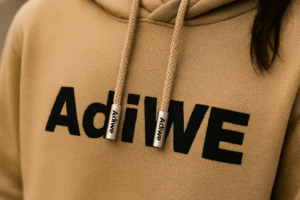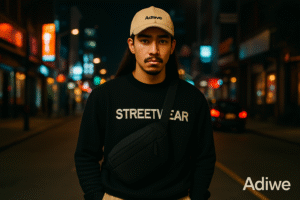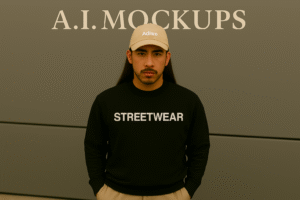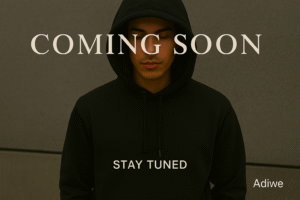Feeling overshadowed by huge streetwear brands? Their massive budgets and reach seem unbeatable. But small brands have unique strengths to win.
Yes, small brands can compete by leveraging niche focus, authentic storytelling, superior quality, strong community building, and agility, areas where giants often fall short.
As Sunny from Adiwe, a Chinese factory specializing in B2B wholesale streetwear, I've seen many smaller, trend-focused brands carve out successful spaces. They might not have the marketing muscle of global giants, but they possess other powerful advantages. Clients like "Fifty Fifty" from England, who focus on unique designs and quality for their young audience, demonstrate this perfectly. Let's explore how your small streetwear brand can not only survive but thrive against the big players.
How Can Finding a Unique Niche Help Small Brands Cut Through the Noise?
Is your brand lost in the crowded streetwear market? Competing everywhere means winning nowhere. A specific niche helps you attract dedicated fans.
Focusing on a specific subculture, aesthetic, or value proposition allows small brands to attract a loyal following that resonates deeply with their specialized offering, reducing direct competition.
!
Dive deeper Paragraph:
Big brands often try to appeal to everyone. This broad approach can dilute their message. Small brands, however, can go deep. Think about it: what specific community or style isn't being fully served? Maybe it's eco-conscious streetwear, techwear for a particular hobby, or designs inspired by a unique local art scene. When I work with emerging clothing brands, I always ask about their core audience. "Fifty Fifty," for instance, targets young people who like their specific brand – that implies a distinct style or ethos they've cultivated. By niching down, you're not just selling hoodies or t-shirts; you're selling an identity. We at Adiwe can support this by offering customizable fabrics and personalized designs, allowing brands to create products that perfectly match their niche. This targeted approach means your marketing budget works harder, and your designs speak directly to the right people. This builds a stronger, more engaged customer base than a giant chasing mass appeal. You become the go-to brand for that specific interest.
Why is Authentic Storytelling a Superpower for Emerging Streetwear Labels?
Are customers tired of generic corporate branding? Big brands often sound impersonal and distant. Your genuine story creates a real connection.
Authentic storytelling allows small brands to build trust and emotional connections with consumers who crave transparency and relatability, something large corporations often struggle to achieve genuinely.

Dive deeper Paragraph:
People connect with people, not faceless corporations. As a small brand, your story – your "why" – is one of your most powerful assets. What inspired you to start? What values drive your designs? What message do you want to send? Share it! This is something I've seen work wonders. When a brand owner, like the one behind "Fifty Fifty," confidently leads their brand's narrative, it resonates. They're not just selling hoodies; they're selling a piece of their vision. Big brands might try to manufacture stories, but authenticity is hard to fake. Use your "About Us" page, your social media, even your hang tags to tell your unique journey.
Ways to Share Your Story:
- Founder's Journey: Explain your personal connection to the brand.
- Design Inspiration: Show what influences your aesthetic.
- Ethical Commitments: Highlight sustainable practices or community support.
At Adiwe, when we produce custom streetwear, we see ourselves as helping to bring these stories to life through tangible, top-quality products. Your personal passion and commitment are relatable. They can attract customers who want to support a brand with a real soul, not just a massive logo. This connection builds loyalty beyond just the product itself.
Can Uncompromising Quality Become a Small Brand’s Secret Weapon?
Struggling to justify your prices against cheaper giants? Fast fashion often prioritizes quantity over quality. Superior craftsmanship creates lasting value and loyalty.
Absolutely. Focusing on top-quality materials, superior craftsmanship, and durable construction can differentiate small brands, attracting discerning customers willing to pay more for lasting value.
Dive deeper Paragraph:
Many big streetwear names, especially those leaning into fast fashion, sometimes compromise on quality to hit price points or rapidly changing trends. This creates an opening for smaller brands. If you can offer products that not only look good but also feel premium and are built to last, you tap into a market segment that values durability and craftsmanship. I see this with clients like "Fifty Fifty." Their pain point is that many manufacturers can't reproduce their complex designs or meet their quality expectations. That's where a factory like Adiwe, with its 5 production lines and focus on personalized design and customizable fabrics, becomes a crucial partner. We help brands deliver on their promise of quality.
Focus Areas for Quality:
| Feature | Benefit | How Adiwe Supports |
|---|---|---|
| Fabrics | Better feel, durability, unique textures | Sourcing premium, customizable, sustainable options |
| Construction | Longevity, comfort, refined look | Skilled workers, advanced machinery, attention to detail |
| Craftsmanship | Perfect execution of complex, trendy designs | Expertise in specialized techniques, custom logos/accessories |
This focus on quality builds a reputation. Word-of-mouth spreads, and customers return because they trust your products. It's not just about the initial sale; it's about creating a loyal customer base that appreciates the superior value you offer, justifying a potentially higher price point.
How Does Building a Strong Community Give Small Brands a Competitive Edge?
Finding it hard to get noticed by new customers? Big brands dominate ad spaces and media. A loyal community becomes your best marketing team.
A strong, engaged community provides invaluable feedback, user-generated content, and word-of-mouth marketing, creating organic growth that large brands often struggle to replicate authentically.
Dive deeper Paragraph:
Big brands have followers; small brands can build true communities. This isn't just about numbers on social media; it's about fostering genuine two-way interaction. Engage with your customers, listen to their feedback, involve them in your journey. I've seen trend brands and KOLs excel at this. They create a sense of belonging. This community becomes your biggest advocate. They'll share your products, tag you in posts, and recommend you to friends. This organic reach is incredibly powerful and often more trusted than paid advertising.
Community Building Tactics:
- Interactive Content: Run polls about new designs, host Q&A sessions with the founder.
- User-Generated Content (UGC): Create a unique hashtag and feature customer photos.
- Exclusive Access: Offer early bird releases or special discounts to loyal community members or newsletter subscribers.
- Events (Online/Offline): Organize virtual meet-ups, pop-up shops, or local gatherings if feasible.
This direct engagement also provides invaluable insights. Your community can tell you what they love, what they want next, and how you can improve. It's like having a built-in focus group. While large brands might use expensive market research, you can get richer, more passionate feedback directly from the people who matter most – your customers.
How Can Agility and Quick Innovation Help Small Brands Outmaneuver Giants?
Are big brands too slow to react to new trends? Their bureaucratic structures can stifle creativity. Your speed allows you to innovate and adapt quickly.
Small brands can swiftly adapt to emerging trends, test new ideas, and pivot strategies without the bureaucratic delays faced by large corporations, keeping their offerings fresh and exciting.
Dive deeper Paragraph:
Large corporations often move like big ships – slowly. They have multiple layers of approval, established supply chains, and massive marketing campaigns planned months in advance. This makes it hard for them to react quickly to sudden shifts in trends or consumer preferences. Small brands, on the other hand, can be nimble. You can spot a micro-trend, design a new piece, and get it into production much faster. This is where having a responsive manufacturing partner like Adiwe is key. We work with brands on personalized designs and can help turn around samples and production runs efficiently. "Fifty Fifty" needs a supplier who can handle complex designs – this often means innovative techniques and quick adaptation.
Leveraging Agility:
- Experiment Freely: Launch limited-edition drops or capsule collections to test new styles without massive financial risk.
- Respond to Feedback: Quickly incorporate customer suggestions or market observations into upcoming designs or re-stocks.
- Collaborate Spontaneously: Jump on timely collaboration opportunities with artists, influencers, or other complementary brands.
- Adapt Marketing: Shift your messaging or try new social media platforms as soon as you see an opportunity.
This agility allows you to stay ahead of the curve, offering "very trendy" products that capture the current mood. While big brands are still in meetings, you can be launching your next hit. This ability to innovate and adapt rapidly is a significant competitive advantage in the fast-paced world of streetwear.Conclusion
Small brands can definitely compete. By being niche, authentic, quality-focused, community-driven, and agile, you can carve out your own successful space in the streetwear world.




